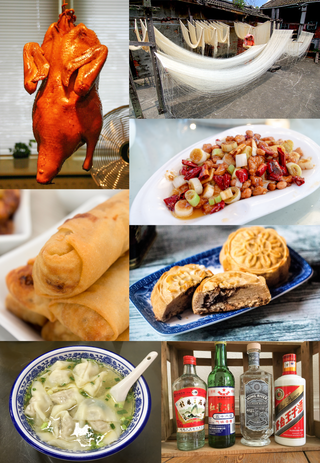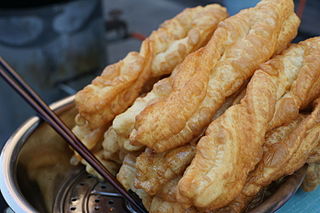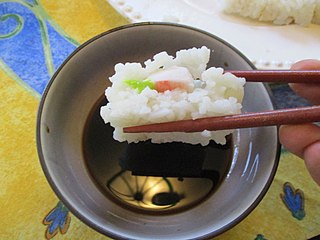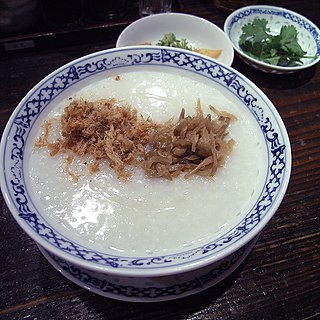
Chinese cuisine comprises cuisines originating from China, as well as from Chinese people from other parts of the world. Because of the Chinese diaspora and the historical power of the country, Chinese cuisine has profoundly influenced many other cuisines in Asia and beyond, with modifications made to cater to local palates. Chinese food staples such as rice, soy sauce, noodles, tea, chili oil, and tofu, and utensils such as chopsticks and the wok, can now be found worldwide.

Youtiao, known in Southern China as yu char kway, is a long golden-brown deep-fried strip of wheat flour dough of Chinese origin and also popular in other East and Southeast Asian cuisines.

A dip or dip sauce is a common condiment for many types of food. Dips are used to add flavor or texture to a food, such as pita bread, dumplings, crackers, chopped raw vegetables, fruits, seafood, cubed pieces of meat and cheese, potato chips, tortilla chips, falafel, and sometimes even whole sandwiches in the case of jus. Unlike other sauces, instead of applying the sauce to the food, the food is typically placed or dipped into the sauce.

Buffalo mozzarella is a mozzarella made from the milk of the Italian Mediterranean buffalo. It is a dairy product traditionally manufactured in Campania, especially in the provinces of Caserta and Salerno.

Fermented tofu is a Chinese condiment consisting of a form of processed, preserved tofu used in East Asian cuisine. The ingredients typically are soybeans, salt, rice wine and sesame oil or vinegar. In mainland China the product is often freshly distributed. In overseas Chinese communities living in Southeast Asia, commercially packaged versions are often sold in jars containing blocks 2- to 4-cm square by 1 to 2 cm thick soaked in brine with select flavorings.

Tangyuan are a traditional Chinese dessert made of glutinous rice shaped into balls that are served in a hot broth or syrup. They come in varying sizes, anything between a marble to a ping-pong ball, and are sometimes stuffed with filling. Tangyuan are traditionally eaten during the Lantern Festival, but because the name is a homophone for reunion and symbolizes togetherness and completeness, this dish is also served at weddings, family reunions, Chinese New Year, and the Dōngzhì festival.

Kue are bite-sized snacks or desserts originally from what is now Indonesia but have since spread throughout Southeast Asia. Kue is a fairly broad term in Indonesian to describe a wide variety of snacks including cakes, cookies, fritters, pies, scones, and patisserie. Kue are made from a variety of ingredients in various forms; some are steamed, fried or baked. They are popular snacks in Indonesia, which has the largest variety of kue. Because of the countries' historical colonial ties, Koeé (kue) is also popular in the Netherlands.

White cut chicken or white sliced chicken is a type of siu mei. Unlike most other meats in the siu mei category, this particular dish is not roasted, but poached. The dish is common to the cultures of Southern China, including Guangdong, Fujian and Hong Kong. In Hawaii, this popular dish is known as cold ginger chicken.

Uyghur cuisine is the cuisine of the Uyghur people, which are mainly situated in the autonomous region of Xinjiang.

Rushan is a cow's milk cheese of Yunnan, China. It is traditionally made by the Bai people, who call it nvxseiz, the etymology of which is unclear.

Sai Kwan or Xiguan is an ancient town and an area in the Liwan district of Guangzhou, China, which was located west of the old walled city. The Thirteen Factories trading enclave was located on its southern shore and the Shamian enclave was constructed beside it. Xiguan continues to have a distinctive culture within Guangzhou and some residents speak a distinctive dialect of Cantonese.

Tzfatit, or Tzfat cheese is a semi-hard salty cheese produced in Israel, originally from sheep's milk. It was first produced in Safed in 1840 and is still produced there by descendants of the original cheese makers.

Bubur ayam is an Indonesian chicken congee. It is rice congee with shredded chicken meat served with some condiments, such as chopped scallion, crispy fried shallot, celery, tongcay or chai poh, fried soybean, crullers, both salty and sweet soy sauce, and sometimes topped with yellow chicken broth and kerupuk. Unlike many other Indonesian dishes, the dish is not spicy as the sambal or chili paste is often served separately. It is a favourite breakfast food, served by humble travelling vendors, warung, fast food establishments, and five-star hotel restaurants. Travelling bubur ayam vendors frequently pass through residential streets in the morning selling the dish.

Congee is a form of savoury rice porridge made by boiling rice in a large amount of water until the rice softens. Depending on rice-water ratio, the thickness of congee varies from a Western oatmeal porridge to a gruel. Since the history of rice cultivation in Asia stretches back to the Baiyue-inhabited lower Yangtze circa 10000 BC, congee is unlikely to have appeared before that date. Congee is typically served with side dishes, or it can be topped with meat, fish and pickled vegetables.

Teochew porridge is a Teochew rice porridge dish often accompanied with various small plates of side dishes. Teochew porridge is served as a banquet of meats, fish egg, and vegetables that is eaten with plain rice porridge. It may be simply prepared plain, or include sweet potatoes. The rice grains, while softened from cooking, are still whole and not in an overly starchy state. Because the porridge is served plain, it is suitable to accompany salty side dishes. The recipe originated in Chaozhou and was later modified by early immigrants prepared in Malaysia and Singapore over the generations to suit local tastes.

Fried milk, also known as Daliang Fried Fresh Milk and Crispy Milk Curd, is a dessert of Cantonese cuisine, which originated in the Shunde District of Guangdong, China. This is a typical dish of the soft-fried method, with a golden and crispy outer skin, soft and white on the inside, with a milky flavor. Milk is thickened with flour, cornstarch, and sugar. Thoroughly mix the fried milk ingredients and cook over low heat, stirring constantly until the mixture thickens and becomes sticky. Pour the mixture into a container and cool or refrigerate until it solidifies. Once firm, cut it into rectangular pieces and coat each piece with a batter typically made from cornstarch, water, and eggs. Then, deep fry the battered pieces in hot oil until golden brown.

Watermelon milk is a Taiwanese milk beverage made from fresh watermelon and milk, the most common of which is produced by Uni-President Enterprises Corporation in Taiwan.
















